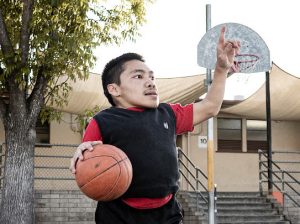As part of the KPBS Seek Out Science project, a San Diego State University physics professor went to Sunnyslope Elementary School in Otay Mesa to teach kids about science.
Sam Oseroff, a scientist and physics professor, participated in the project, which was designed to pair scientists with different elementary, junior high and high school teachers in the San Diego area in order to spark an interest in science in the younger generation.
KPBS is a public broadcasting station that mainly airs educational and informational programs.
The scientists visit the classroom for a day and are often asked back by both the teachers and the students, said Monica Medina, coordinator for the program.
The theme of this year’s Seek Out Science project is “Life on the Brink.” Its focus is biological diversity on land, Medina said.
Oseroff visited a junior high school in Linda Vista last November and visited Sunnyslope on Dec. 3. He said the most important thing for a student to learn is that science can be fun.
“Science is not some obscure subject that only really smart people can understand,” he said. “Science works at every moment in our lives. Thanks to science they are having a better life than children did a century ago.”
Science teachers must have an understanding of the subject they are teaching, and must present information in a way that is interesting to students, Oseroff said.
“If you start to use big words you’ll lose their interest in about 20 seconds,” he said. “You cannot expect children who are 11 and 12 years old to describe things that are very deep.”
Instead of using complicated methods to teach science, Oseroff starts his lecture with an experiment that looks like magic.
After that, he said, the children’s interest is sparked. He then makes it real by explaining exactly how and what basic principles of physics and science were used.
For example, in one of his experiments, Oseroff used a can of cold water and a can of boiling water. He then combines the two which causes the water to smash.
To the children, he said, this looks like magic or a big mystery. Oseroff then explains the principles which cause the water to react in that way.
“After the experiment I explain what is underneath,” Oseroff said. “I (attempt to answer the questions) why is this important for the people around us? How can we use this to make certain tools that will make what I just showed useful and make the quality of life better?”
The program is in its second year. Last year’s theme was “Oceans of Life” and focused on vast diversity of the ocean.
“You can’t put a price on the value of this program,” Medina said. “Kids get inspired by the scientists. Having them in the classroom makes the material more real.”
Oseroff stressed the importance of knowing how to teach as well as knowing what to teach kids.
“Elementary school teachers have too many subjects to be responsible for,” he said. “It’s hard for them to be an expert in science. (That’s why) programs like this are useful.”
The project’s main focus is to get minorities and females interested in science.
“The program is open to everyone,” Medina said, “but we hope to inspire particularly girls and minorities. These groups tend to feel that there is a barrier (between them and science). They aren’t often around role models who are involved in science.”
For this reason, the Seek Out Science project targets women or minority scientists in order to give children these role models.
In the case of Oseroff, the class he spoke to was entirely Spanish-speaking, which is also his first language.
“I encouraged them to learn English and go to college,” he said. “These are very important things in order to be successful.”
During their pilot year, KPBS teamed 25 teachers with as many scientists. This year more than 125 scientists signed up and 80 teachers are involved.
The scientists are provided with all the basic materials needed to instruct the class. The teacher’s kit includes an audio tape and other materials related to the theme. Last year the kit included a detailed map of the ocean floor, Medina said.
The Seek Out Science project recruits scientists from SDSU, University of California at San Diego, private labs and other institutions of higher learning.









